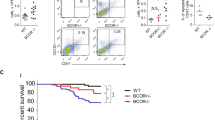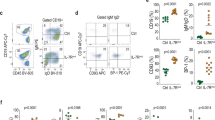Abstract
The BCR-ABL oncoprotein exhibits deregulated protein tyrosine kinase activity and is implicated in the pathogenesis of Philadelphia chromosome (Ph)-positive human leukemias. Here, we report that ectopic expression of p210BCR-ABL in the megakaryoblastic Mo7e cell line and in primary human CD34+ progenitors trigger erythroid differentiation at the expense of megakaryocyte (MK) differentiation. Clonal culture of purified CD41+CD42− cells, a population highly enriched in MK progenitors, combined with the conditional expression of p210BCR-ABL tyrosine kinase activity by imatinib identified a true lineage reprogramming. In both Mo7e or CD41+CD42− cells transduced with p210BCR-ABL, lineage switching was associated with a downregulation of the friend leukemia Integration 1 (FLI-1) transcription factor. Re-expression of FLI-1 in p210BCR-ABL-transduced Mo7e cells rescued the megakaryoblastic phenotype. Altogether, these results demonstrate that alteration of signal transduction via p210BCR-ABL reprograms MK cells into erythroid cells by a downregulation of FLI-1. In addition, our findings underscore the role of kinases in lineage choice and infidelity in pathology and suggest that downregulation of FLI-1 may have important implications in CML pathogenesis.
This is a preview of subscription content, access via your institution
Access options
Subscribe to this journal
Receive 12 print issues and online access
$259.00 per year
only $21.58 per issue
Buy this article
- Purchase on Springer Link
- Instant access to full article PDF
Prices may be subject to local taxes which are calculated during checkout






Similar content being viewed by others
Accession codes
References
Groffen J, Stephenson JR, Heisterkamp N, de Klein A, Bartram CR, Grosveld G . Philadelphia chromosomal breakpoints are clustered within a limited region, BCR, on chromosome 22. Cell 1984; 36: 93–99.
Ben-Neriah Y, Daley GQ, Mes-Masson AM, Witte ON, Baltimore D . The chronic myelogenous leukemia-specific P210 protein is the product of the BCR/ABL hybrid gene. Science 1986; 233: 212–214.
Konopka JB, Witte ON . Detection of C-ABL tyrosine kinase activity in vitro permits direct comparison of normal and altered ABL gene products. Mol Cell Biol 1985; 5: 3116–3123.
Bettelheim P, Lutz D, Majdic O, Paietta E, Haas O, Linkesch W et al. Cell lineage heterogeneity in blast crisis of chronic myeloid leukaemia. Br J Haematol 1985; 59: 395–409.
Eaves CJ, Eaves AC . Cell culture studies in CML. Baillieres Clin Haematol 1987; 1: 931–961.
Hoppin EC, Lewis JP . Polycythemia rubra vera progressing to Ph1-positive chronic myelogenous leukemia. Ann Intern Med 1975; 83: 820–823.
Eaves C, Cashman J, Eaves A . Defective regulation of leukemic hematopoiesis in chronic myeloid leukemia. Leuk Res 1998; 22: 1085–1096.
Saikia T, Advani S, Dasgupta A, Ramakrishnan G, Nair C, Gladstone B et al. Characterisation of blast cells during blastic phase of chronic myeloid leukaemia by immunophenotyping-experience in 60 patients. Leuk Res 1988; 12: 499–506.
Klein E, Ben-Bassat H, Neumann H, Ralph P, Zeuthen J, Polliack A et al. Properties of the K562 cell line, derived from a patient with chronic myeloid leukemia. Int J Cancer 1976; 18: 421–431.
Deininger MW, Goldman JM, Melo JV . The molecular biology of chronic myeloid leukemia. Blood 2000; 96: 3343–3356.
Perrotti D, Cesi V, Trotta R, Guerzoni C, Santilli G, Campbell K et al. BCR-ABL suppresses C/EBPalpha expression through inhibitory action of hnRNP E2. Nat Genet 2002; 30: 48–58.
Klein F, Feldhahn N, Herzog S, Sprangers M, Mooster JL, Jumaa H et al. BCR-ABL1 induces aberrant splicing of IKAROS and lineage infidelity in pre-B lymphoblastic leukemia cells. Oncogene 2006; 25: 1118–1124.
Elefanty AG, Cory S . BCR-ABL-induced cell lines can switch from mast cell to erythroid or myeloid differentiation in vitro. Blood 1992; 79: 1271–1281.
Fang G, Kim CN, Perkins CL, Ramadevi N, Winton E, Wittmann S et al. CGP57148B (STI-571) induces differentiation and apoptosis and sensitizes BCR-ABL-positive human leukemia cells to apoptosis due to antileukemic drugs. Blood 2000; 96: 2246–2253.
Schuster C, Forster K, Dierks H, Elsasser A, Behre G, Simon N et al. The effects of BCR-ABL on C/EBP transcription-factor regulation and neutrophilic differentiation are reversed by the ABL kinase inhibitor imatinib mesylate. Blood 2003; 101: 655–663.
Daley GQ, Van Etten RA, Baltimore D . Induction of chronic myelogenous leukemia in mice by the P210bcr/abl gene of the Philadelphia chromosome. Science 1990; 247: 824–830.
Kelliher MA, McLaughlin J, Witte ON, Rosenberg N . Induction of a chronic myelogenous leukemia-like syndrome in mice with V-ABL and BCR/ABL. Proc Natl Acad Sci USA 1990; 87: 6649–6653.
Chalandon Y, Jiang X, Hazlewood G, Loutet S, Conneally E, Eaves A et al. Modulation of p210(BCR-ABL) activity in transduced primary human hematopoietic cells controls lineage programming. Blood 2002; 99: 3197–3204.
Adolfsson J, Mansson R, Buza-Vidas N, Hultquist A, Liuba K, Jensen CT et al. Identification of Flt3+ lympho-myeloid stem cells lacking erythro-megakaryocytic potential a revised road map for adult blood lineage commitment. Cell 2005; 121: 295–306.
McDonald TP, Sullivan PS . Megakaryocytic and erythrocytic cell lines share a common precursor cell. Exp Hematol 1993; 21: 1316–1320.
Vannucchi AM, Paoletti F, Linari S, Cellai C, Caporale R, Ferrini PR et al. Identification and characterization of a bipotent (erythroid and megakaryocytic) cell precursor from the spleen of phenylhydrazine-treated mice. Blood 2000; 95: 2559–2568.
Debili N, Coulombel L, Croisille L, Katz A, Guichard J, Breton-Gorius J et al. Characterization of a bipotent erythro-megakaryocytic progenitor in human bone marrow. Blood 1996; 88: 1284–1296.
Papayannopoulou T, Brice M, Farrer D, Kaushansky K . Insights into the cellular mechanisms of erythropoietin-thrombopoietin synergy. Exp Hematol 1996; 24: 660–669.
Perry C, Soreq H . Transcriptional regulation of erythropoiesis. Fine tuning of combinatorial multi-domain elements. Eur J Biochem 2002; 269: 3607–3618.
Cantor AB, Orkin SH . Transcriptional regulation of erythropoiesis: an affair involving multiple partners. Oncogene 2002; 21: 3368–3376.
Shivdasani RA . Molecular and transcriptional regulation of megakaryocyte differentiation. Stem Cells 2001; 19: 397–407.
Wang X, Crispino JD, Letting DL, Nakazawa M, Poncz M, Blobel GA . Control of megakaryocyte-specific gene expression by GATA-1 and FOG-1: role of Ets transcription factors. EMBO J 2002; 21: 5225–5234.
Geay JF, Buet D, Zhang Y, Foudi A, Jarrier P, Berthebaud M et al. p210BCR-ABL inhibits SDF-1 chemotactic response via alteration of CXCR4 signaling and downregulation of CXCR4 expression. Cancer Res 2005; 65: 2676–2683.
Berthebaud M, Riviere C, Jarrier P, Foudi A, Zhang Y, Compagno D et al. RGS16 is a negative regulator of SDF-1-CXCR4 signaling in megakaryocytes. Blood 2005; 106: 2962–2968.
Lacroix L, Lazar V, Michiels S, Ripoche H, Dessen P, Talbot M et al. Follicular thyroid tumors with the PAX8-PPARgamma1 rearrangement display characteristic genetic alterations. Am J Pathol 2005; 167: 223–231.
Raslova H, Komura E, Le Couedic JP, Larbret F, Debili N, Feunteun J et al. FLI1 monoallelic expression combined with its hemizygous loss underlies Paris-Trousseau/Jacobsen thrombopenia. J Clin Invest 2004; 114: 77–84.
Druker BJ, Tamura S, Buchdunger E, Ohno S, Segal GM, Fanning S et al. Effects of a selective inhibitor of the ABL tyrosine kinase on the growth of BCR-ABL positive cells. Nat Med 1996; 2: 561–566.
Hart A, Melet F, Grossfeld P, Chien K, Jones C, Tunnacliffe A et al. FLI-1 is required for murine vascular and megakaryocytic development and is hemizygously deleted in patients with thrombocytopenia. Immunity 2000; 13: 167–177.
Spyropoulos DD, Pharr PN, Lavenburg KR, Jackers P, Papas TS, Ogawa M et al. Hemorrhage, impaired hematopoiesis, and lethality in mouse embryos carrying a targeted disruption of the FLI-1 transcription factor. Mol Cell Biol 2000; 20: 5643–5652.
Deveaux S, Filipe A, Lemarchandel V, Ghysdael J, Romeo PH, Mignotte V . Analysis of the thrombopoietin receptor (MPL) promoter implicates GATA and ETS proteins in the co-regulation of megakaryocyte-specific genes. Blood 1996; 87: 4678–4685.
Eisbacher M, Holmes ML, Newton A, Hogg PJ, Khachigian LM, Crossley M et al. Protein–protein interaction between FLI-1 and GATA-1 mediates synergistic expression of megakaryocyte-specific genes through cooperative DNA binding. Mol Cell Biol 2003; 23: 3427–3441.
Jackers P, Szalai G, Moussa O, Watson DK . ETS-dependent regulation of target gene expression during megakaryopoiesis. J Biol Chem 2004; 279: 52183–52190.
Athanasiou M, Mavrothalassitis G, Sun-Hoffman L, Blair DG . FLI-1 is a suppressor of erythroid differentiation in human hematopoietic cells. Leukemia 2000; 14: 439–445.
Starck J, Cohet N, Gonnet C, Sarrazin S, Doubeikovskaia Z, Doubeikovski A et al. Functional cross-antagonism between transcription factors FLI-1 and EKLF. Mol Cell Biol 2003; 23: 1390–1402.
Starck J, Doubeikovski A, Sarrazin S, Gonnet C, Rao G, Skoultchi A et al. SPI-1/PU.1 is a positive regulator of the FLI-1 gene involved in inhibition of erythroid differentiation in friend erythroleukemic cell lines. Mol Cell Biol 1999; 19: 121–135.
Kawada H, Ito T, Pharr PN, Spyropoulos DD, Watson DK, Ogawa M . Defective megakaryopoiesis and abnormal erythroid development in FLI-1 gene-targeted mice. Int J Hematol 2001; 73: 463–468.
Masuya M, Moussa O, Abe T, Deguchi T, Higuchi T, Ebihara Y et al. Dysregulation of granulocyte, erythrocyte, and NK cell lineages in FLI-1 gene-targeted mice. Blood 2005; 105: 95–102.
Athanasiou M, Clausen PA, Mavrothalassitis GJ, Zhang XK, Watson DK, Blair DG . Increased expression of the ETS-related transcription factor FLI-1/ERGB correlates with and can induce the megakaryocytic phenotype. Cell Growth Differ 1996; 7: 1525–1534.
Eaves AC, Eaves CJ . Abnormalities in the erythroid progenitor compartments in patients with chronic myelogenous leukemia (CML). Exp Hematol 1979; 7 (Suppl 5): 65–75.
Goldman JM, Shiota F, Th'ng KH, Orchard KH . Circulating granulocytic and erythroid progenitor cells in chronic granulocytic leukaemia. Br J Haematol 1980; 46: 7–13.
Clarkson BD, Strife A, Wisniewski D, Lambek C, Carpino N . New understanding of the pathogenesis of CML: a prototype of early neoplasia. Leukemia 1997; 11: 1404–1428.
Marley SB, Lewis JL, Goldman JM, Gordon MY . Abnormal kinetics of colony formation by erythroid burst-forming units (BFU-E) in chronic myeloid leukaemia. Br J Haematol 1996; 93: 878–883.
Acknowledgements
We are grateful to Frederic Larbret and Yann Lecluse (IFR54, Villejuif, France) for flow cytometric sorting experiments and François Delhommeau (INSERM U790) for cytological studies. We are indebted to Françoise Wendling for helpful discussions during the preparation of the manuscript. We thank Elizabeth Buchdunger (Novartis, Basel Switzerland) for providing Imatinib mesylate.
This work was supported by grants from the Institut National de la Santé et de la Recherche Médicale, the Institut Gustave Roussy, the Centre National de la Recherche Scientifique, the Ligue Nationale contre le Cancer (WV and FM ‘équipes labellisées LIGUE’) and the Association de Recherche contre le Cancer (grant 4309 to FL). DB was supported by PhD fellowships from the Ministère de la Recherche.
Author information
Authors and Affiliations
Corresponding author
Additional information
Supplementary Information accompanies the paper on the Leukemia website (http://www.nature.com/leu)
Supplementary information
Rights and permissions
About this article
Cite this article
Buet, D., Raslova, H., Geay, JF. et al. p210BCR-ABL reprograms transformed and normal human megakaryocytic progenitor cells into erythroid cells and suppresses FLI-1 transcription. Leukemia 21, 917–925 (2007). https://doi.org/10.1038/sj.leu.2404600
Received:
Revised:
Accepted:
Published:
Issue Date:
DOI: https://doi.org/10.1038/sj.leu.2404600
Keywords
This article is cited by
-
Improvement of platelet dysfunction in chronic myelogenous leukemia following treatment with imatinib: a case report
Journal of Medical Case Reports (2011)



